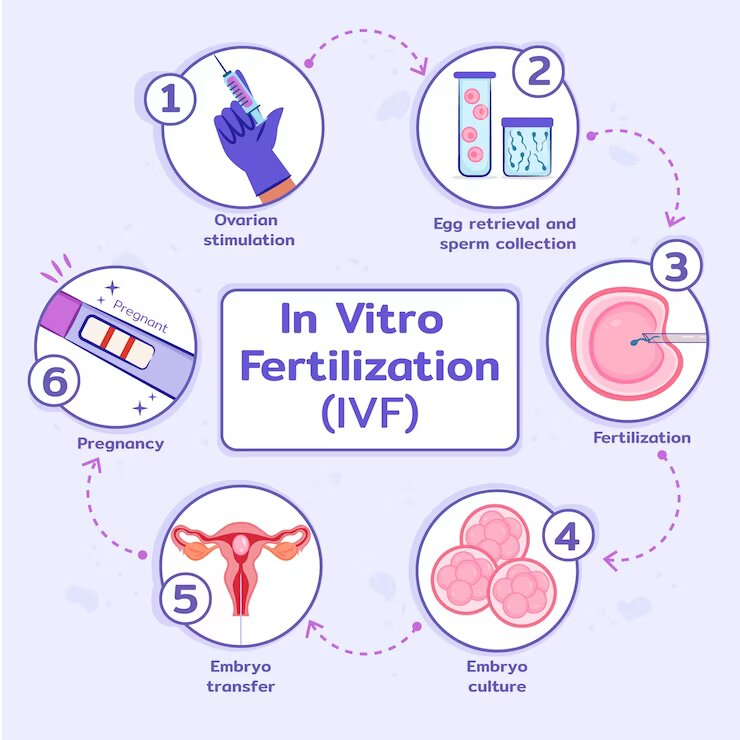Establishing healthy behaviors should be one of the first steps taken when preparing for in vitro fertilization (IVF). This is necessary to guarantee the best possible health of your sperm and eggs. To start, we advise that you look at your diet to ensure that it is balanced and that you are getting enough nutrients to maintain healthy blood sugar levels and a healthy weight. The following foods should be a part of your diet or avoided during you while you get Prepare for IVF Treatment:
How to Prepare for In-Vitro-Fertilization (IVF) Treatment?

- People frequently forget the importance of water. You should drink at least 1.5 liters of filtered or mineral water daily.
- Blueberries, raspberries, strawberries, and pomegranates are all good sources of antioxidants, which help to reduce the amount of harm that the environment causes to our cells. These fruits and vegetables are part of the “five a day” diet. The essential prenatal elements calcium, iron, and folate are abundant in dark, leafy greens like spinach and kale. Broccoli is another excellent food that you should include in your diet.
- Whole grains, oats, quinoa, lentils, and chickpeas fall within this category.
- Fats that are excellent for you, such as those in almonds, eggs from free-range chickens, seeds, and lentils, as well as salmon and other fatty fish. If you’re going to eat meat, opt for organic fowl to obtain a good serving of lean protein and essential fatty acids. An additional excellent choice is live, organic yogurt.
- If you regularly drink coffee, limit your caffeine intake to no more than one cup daily. In addition to coffee, other foods and beverages that contain caffeine include chocolate, green or black tea, and some soft drinks. Additionally, it is advised to stay away from decaffeinated coffee and tea as much as possible because these beverages already include various chemicals used in the decaffeination process.
- Alcohol, especially when eaten in moderation, can lengthen the entire pregnancy process; as a result, it should be avoided whenever feasible.
- Anything that contains additives, coloring, sugar, or emulsifiers should be avoided at all costs. Make it a point to obtain as much food as possible from natural sources.
- If you and your partner want to be certain that you are getting all the necessary vitamins and nutrients, you should speak with your primary care physician about the supplement options you can consider.
These are the food items that should be a part of your diet or avoided during your IVF Treatment.
Chemicals to Stay Away from Before an IVF Procedure
It is in everyone’s best interest to have as few environmental toxins in their systems as possible before, during, and especially after an embryo transfer utilizing in vitro fertilization (IVF), the procedure in which the fertilized egg is implanted into the uterus. This does not necessarily imply that you must stop receiving the aesthetic procedures you already receive. For example, when getting your hair cut or nails done, always choose a salon with sufficient ventilation and products with fewer chemicals. Your exposure to potentially dangerous chemicals will be reduced as a result. Similar rules apply to manicures and pedicures, with the caveat that black nail polish and just about any other sort must be removed before egg collection. This is because dark nail paint may make it difficult for the pulse oximeter device to determine the precise amount of oxygen on your finger.
If you smoke and want to improve the success rate of your IVF process, you should give up smoking.
Sexual Activity and IVF
Although it is not harmful to have sex during the early stages of ovarian stimulation, it is highly advised that you avoid having sex during the later stages of the cycle because there is a chance that you could experience follicular rupture and ovarian torsion. Ovaries are bigger than other reproductive organs, making sexual activity uncomfortable or painful. If you have intercourse without using protection, there’s a chance that more than one of your eggs will ovulate prematurely, which could result in multiple pregnancies.
Your partner must abstain from sexual activity for two to five days before collecting their sperm sample to increase the likelihood of getting pregnant.
How to Take Care of Your Mental Health?
Even though we know that stress is bad for us, especially when going through a difficult moment, it is not always easy to control our anxiety. Stress can affect fertility by releasing the hormone cortisol, which harms fertility. Stress may also impact fertility because cortisol can lead to hormonal abnormalities in both men and women. To learn more about the connection between stress and fertility, go here.
Ensuring you are providing yourself with the necessary care and keeping this in mind is even more important as you prepare for IVF. Excellent ways to decompress include:
Make sure you’re getting your recommended daily allowance of vitamins, and if you’re unsure which ones are best for you, consult your primary care provider.
Making a connection with oneself, improving concentration, and lowering stress are all facilitated by meditation. Exercises that improve your breathing can significantly improve your health and only take 10 to 15 minutes out of your day.
It has been demonstrated that acupuncture, a form of complementary therapy, can minimize the effect of stress hormones on the body, aiding in maintaining a healthy balance of hormones important for fertility.
Writing down your thoughts in a journal is a great way to release stress and repressed emotions. Since journaling helps you better organize your thoughts and better understand your feelings, it can be therapeutically beneficial.
By prioritizing yourself, you shouldn’t put off living your life; book those trips you’ve been dreaming about, embark on a new endeavor, or get that clothing you’ve had your eye on. These concerns will become less important and much easier to handle if you get pregnant. Always look for yourself and spend time doing things that make you happy.
You are free to do so whenever you need to if you think learning more about fertility and the IVF process will put your mind at ease. Just be careful not to let the sheer volume of information overwhelm you; allow yourself up to 45 minutes daily to read, and set a timer to ensure you don’t exceed your given time.
What Kind of Support Will You Need?
You must take good care of your relationship and each other during this difficult time because going through IVF can be difficult for you and your partner. Spend some time discussing your feelings, making sure that you both understand the demands each of you has on the other and how you would like to be supported throughout the process without blaming one another. Include your partner in the IVF process so you may discuss and make all the decisions together.
Your partner can be very helpful by taking on tasks like making sure you have enough medication and injections, educating them about fertility, how to get your body ready for IVF treatment, and how to offer emotional support because fertility treatment has a significant physiological toll on women.
Ask your healthcare physician or nurse about our fertility counseling program if it may be helpful for you to speak with an IVF specialist.
How to Prepare Yourself Mentally for In Vitro Fertilization?
Keep a healthy mix of optimism and pessimism about your chances. It would help if you arrived at the clinic with a positive outlook and let your IVF doctor or nurse know about anything that makes you anxious.
Plan a stress-relieving activity before or after your visits, such as going for a stroll in the park with your significant other, enjoying a meal together, etc. If your busy schedule permits, plan a massage or acupuncture session.
Any worries you have regarding your therapy should be discussed with your healthcare provider. Even if you feel they are unimportant, please let us know about any new symptoms or side effects you have been experiencing.






